Day-772
Quiz-summary
0 of 20 questions completed
Questions:
- 1
- 2
- 3
- 4
- 5
- 6
- 7
- 8
- 9
- 10
- 11
- 12
- 13
- 14
- 15
- 16
- 17
- 18
- 19
- 20
Information
DAILY MCQ
You have already completed the quiz before. Hence you can not start it again.
Quiz is loading...
You must sign in or sign up to start the quiz.
You have to finish following quiz, to start this quiz:
Results
0 of 20 questions answered correctly
Your time:
Time has elapsed
You have reached 0 of 0 points, (0)
Categories
- Not categorized 0%
- 1
- 2
- 3
- 4
- 5
- 6
- 7
- 8
- 9
- 10
- 11
- 12
- 13
- 14
- 15
- 16
- 17
- 18
- 19
- 20
- Answered
- Review
-
Question 1 of 20
1. Question
Consider the following statements:
Statement I: Caribou is a reindeer species which is not found naturally in India.
Statement II: It is native to tundra and alpine landscapes.
Which one of the following is correct in respect of the above statements?Correct
Answer. B
Explanation:
Statement 1 is correct: Caribou is a reindeer species which is native to Arctic and sub-Arctic regions of North America, Europe and Asia. It is not found in India.
Statement 2 is correct: While India has alpine and tundra climatic conditions in the Himalayan region, caribou is not endemic to India. The polar tundra and alpine ecosystems are suited for the existence of caribou.
Caribou, as part of the deer family, have large hooves that are useful tools for life in the harsh northlands. They are big enough to support the animal’s bulk on snow and to paddle it efficiently through the water.
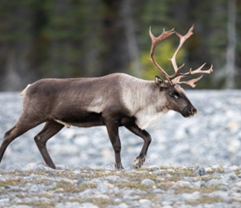
Additional information:
• Caribou belong to a large group of hoofed ungulate mammals in the Order Artiodactyls, which also includes pigs, hippos, camels, giraffes, antelopes, llamas, and many other terrestrial even-toed, hoofed animals.
• Migratory: Caribou make one of the world’s great large-animal migrations. As summer approaches, they head north along well-trod annual routes. Some herds may travel up to 800 miles to get to their summer grazing grounds. They’ll spend the summer months feeding on the abundant grasses and plants of the tundra. An adult caribou can eat 12 pounds of food each day. This is also when they give birth.
• During the winter, it often spends time in less sheltered areas because the wind-swept ground is less snow covered making the lichen easier to access.
• UNIQUE BEHAVIOUR: Caribou have scent glands at the base of their ankles. When an animal senses danger, it will rear up on its hind legs to release a scent that alerts the other caribou.
• DIET: Herbivore. Lichen, sedges and grasses make up the diet of caribou.
Caribou are important to ecosystems, too. When they forage on vegetation in the summer, their droppings add nitrogen to the tundra soil and water.
• Caribou are also an important prey species for many carnivores in the Arctic, including wolves and brown bears.
• IUCN status: VU;
• It is the only successfully semi-domesticated deer on large scale in the world.Incorrect
Answer. B
Explanation:
Statement 1 is correct: Caribou is a reindeer species which is native to Arctic and sub-Arctic regions of North America, Europe and Asia. It is not found in India.
Statement 2 is correct: While India has alpine and tundra climatic conditions in the Himalayan region, caribou is not endemic to India. The polar tundra and alpine ecosystems are suited for the existence of caribou.
Caribou, as part of the deer family, have large hooves that are useful tools for life in the harsh northlands. They are big enough to support the animal’s bulk on snow and to paddle it efficiently through the water.

Additional information:
• Caribou belong to a large group of hoofed ungulate mammals in the Order Artiodactyls, which also includes pigs, hippos, camels, giraffes, antelopes, llamas, and many other terrestrial even-toed, hoofed animals.
• Migratory: Caribou make one of the world’s great large-animal migrations. As summer approaches, they head north along well-trod annual routes. Some herds may travel up to 800 miles to get to their summer grazing grounds. They’ll spend the summer months feeding on the abundant grasses and plants of the tundra. An adult caribou can eat 12 pounds of food each day. This is also when they give birth.
• During the winter, it often spends time in less sheltered areas because the wind-swept ground is less snow covered making the lichen easier to access.
• UNIQUE BEHAVIOUR: Caribou have scent glands at the base of their ankles. When an animal senses danger, it will rear up on its hind legs to release a scent that alerts the other caribou.
• DIET: Herbivore. Lichen, sedges and grasses make up the diet of caribou.
Caribou are important to ecosystems, too. When they forage on vegetation in the summer, their droppings add nitrogen to the tundra soil and water.
• Caribou are also an important prey species for many carnivores in the Arctic, including wolves and brown bears.
• IUCN status: VU;
• It is the only successfully semi-domesticated deer on large scale in the world. -
Question 2 of 20
2. Question
Consider the following statements about the Wildlife Institute of India (WII):
1. It is a not-for-profit organisation primarily concerned with the research in wildlife conservation in the country.
2. It is based in Dehradun, Uttarakhand.
Which of the statements given above is/are incorrect?Correct
Answer. A
Explanation:
Statement 1 is incorrect: Established in 1982, Wildlife Institute of India (WII) is an internationally acclaimed Institution, which offers training program, academic courses and advisory in wildlife research and management. The Institute is actively engaged in research across the breadth of the country on biodiversity related issues. It is an autonomous institution under the Ministry of Environment, Forest and Climate Change.
Statement 2 is correct: The WII is based in Dehradun, Uttarakhand. Its campus is close to Rajaji National Park.
Note: The national tiger census or the All India Tiger Estimation, is done by WII along with NTCA and state forest departments.Incorrect
Answer. A
Explanation:
Statement 1 is incorrect: Established in 1982, Wildlife Institute of India (WII) is an internationally acclaimed Institution, which offers training program, academic courses and advisory in wildlife research and management. The Institute is actively engaged in research across the breadth of the country on biodiversity related issues. It is an autonomous institution under the Ministry of Environment, Forest and Climate Change.
Statement 2 is correct: The WII is based in Dehradun, Uttarakhand. Its campus is close to Rajaji National Park.
Note: The national tiger census or the All India Tiger Estimation, is done by WII along with NTCA and state forest departments. -
Question 3 of 20
3. Question
Consider the following statements about ‘Race to Zero’, sometimes seen in the news:
1. It is a global initiative launched by the UNFCCC.
2. Its objective is to mobilise the non-state actors to achieve net zero carbon emissions by 2030.
3. Members of Race to Zero automatically join countries in the Climate Ambition Alliance.
How many of the above statements are correct?Correct
Answer. C
Explanation:
Statement 1 is correct: ‘Race to Zero’ is a global campaign under the aegis of the UNFCCC to rally leadership and support from businesses, cities, regions, investors for a healthy, resilient, zero carbon recovery that prevents future threats, creates decent jobs, and unlocks inclusive, sustainable growth.
Statements 2 and 3 are correct: Led by the High-Level Champions, Race to Zero mobilizes actors outside of national governments to join the Climate Ambition Alliance, which was launched at the UNSG’s Climate Action Summit 2019 by the President of Chile, Sebastián Piñera. Members of Race to Zero automatically join countries in the Climate Ambition Alliance, and their participation is registered on the Global Climate Action portal.
• It mobilizes a coalition of leading net-zero initiatives, representing 11,309 non-State actors including 8,307 companies, 595 financial institutions, 1,136 cities, 52 states and regions, 1,125 educational institutions and 65 healthcare institutions (as of September 2022). These ‘real economy’ actors join the largest-ever alliance committed to achieving net zero carbon emissions by 2050 at the latest.
• Each of the Race to Zero members below are committed to the same overarching goal: reducing emissions, across all scopes, swiftly and fairly in line with the Paris Agreement, with transparent action plans and robust near-term targets.
• Together they form the largest, growing, alliance of non-state actors committed to taking rigorous and immediate action to halve global emissions by 2030 and deliver a healthier, fairer zero carbon world in time.
• The objective is to build momentum around the shift to a decarbonized economy, where governments must strengthen their contributions to the Paris Agreement. This will send governments a resounding signal that business, cities, regions and investors are united in meeting the Paris goals and creating a more inclusive and resilient economy.Incorrect
Answer. C
Explanation:
Statement 1 is correct: ‘Race to Zero’ is a global campaign under the aegis of the UNFCCC to rally leadership and support from businesses, cities, regions, investors for a healthy, resilient, zero carbon recovery that prevents future threats, creates decent jobs, and unlocks inclusive, sustainable growth.
Statements 2 and 3 are correct: Led by the High-Level Champions, Race to Zero mobilizes actors outside of national governments to join the Climate Ambition Alliance, which was launched at the UNSG’s Climate Action Summit 2019 by the President of Chile, Sebastián Piñera. Members of Race to Zero automatically join countries in the Climate Ambition Alliance, and their participation is registered on the Global Climate Action portal.
• It mobilizes a coalition of leading net-zero initiatives, representing 11,309 non-State actors including 8,307 companies, 595 financial institutions, 1,136 cities, 52 states and regions, 1,125 educational institutions and 65 healthcare institutions (as of September 2022). These ‘real economy’ actors join the largest-ever alliance committed to achieving net zero carbon emissions by 2050 at the latest.
• Each of the Race to Zero members below are committed to the same overarching goal: reducing emissions, across all scopes, swiftly and fairly in line with the Paris Agreement, with transparent action plans and robust near-term targets.
• Together they form the largest, growing, alliance of non-state actors committed to taking rigorous and immediate action to halve global emissions by 2030 and deliver a healthier, fairer zero carbon world in time.
• The objective is to build momentum around the shift to a decarbonized economy, where governments must strengthen their contributions to the Paris Agreement. This will send governments a resounding signal that business, cities, regions and investors are united in meeting the Paris goals and creating a more inclusive and resilient economy. -
Question 4 of 20
4. Question
Consider the following:
1. Diatoms
2. Dinoflagellates
3. Cyanobacteria
4. Copepods
How many of the above are the examples of phytoplankton that form the base of aquatic food chain?Correct
Answer. C
Explanation: Options 1, 2 and 3 are correct.
Phytoplankton are the foundation of the aquatic food web, the primary producers, feeding everything from microscopic, animal-like zooplankton to multi-ton whales. Small fish and invertebrates also graze on the plant-like organisms, and then those smaller animals are eaten by bigger ones.
Examples of phytoplankton include:
• Diatoms
• Dinoflagellates
• Cyanobacteria or blue-green algae
• Coccolithophorids etc.
Option 4 is incorrect: Copepods and Conchs are examples of zooplanktons.Incorrect
Answer. C
Explanation: Options 1, 2 and 3 are correct.
Phytoplankton are the foundation of the aquatic food web, the primary producers, feeding everything from microscopic, animal-like zooplankton to multi-ton whales. Small fish and invertebrates also graze on the plant-like organisms, and then those smaller animals are eaten by bigger ones.
Examples of phytoplankton include:
• Diatoms
• Dinoflagellates
• Cyanobacteria or blue-green algae
• Coccolithophorids etc.
Option 4 is incorrect: Copepods and Conchs are examples of zooplanktons. -
Question 5 of 20
5. Question
Consider the following objectives:
1. Responsible and eco-friendly tourism with commitments to reduce carbon footprint from tourism sector.
2. Reverse and halt land degradation by 2030.
3. Ban on the commercial whaling and deep-sea mining.
‘Glasgow Declaration’ is concerned with how many of the above-mentioned objectives?Correct
Answer. B
Explanation: Options 1 and 2 are correct.
Launched at the UNFCCC COP26 climate negotiations in Glasgow, U.K. in 2021, the Glasgow Declaration concluded with the following:
• Declaration on land and land-use: The historic declaration aims to halt and reverse forest loss and land degradation by 2030. It will cover forests estimated to be over 33.7 million square kilometres. The ten goals under this include:
o Halting natural forest loss by 2030
o Restoring 350 million hectares of degraded landscapes and forestlands
o Improving governance
o Increasing forest finance
o Reducing emissions from deforestation and forest degradation
Note: India did not sign the pledge regarding land and land use.
• Climate Action in Tourism: The Glasgow Declaration is a catalyst for increased urgency about the need to accelerate climate action in tourism and to secure strong actions and commitment to support the global goals to halve emissions over the next decade and reach Net Zero emissions as soon as possible before 2050.
• Food And Climate Declaration: The Glasgow Food and Climate Declaration brings together local and regional authorities from across the world to speak with a unified voice in committing to putting into practice integrated food policies to tackle the climate emergency. The call encourages national governments to take joined-up action on food and climate.Incorrect
Answer. B
Explanation: Options 1 and 2 are correct.
Launched at the UNFCCC COP26 climate negotiations in Glasgow, U.K. in 2021, the Glasgow Declaration concluded with the following:
• Declaration on land and land-use: The historic declaration aims to halt and reverse forest loss and land degradation by 2030. It will cover forests estimated to be over 33.7 million square kilometres. The ten goals under this include:
o Halting natural forest loss by 2030
o Restoring 350 million hectares of degraded landscapes and forestlands
o Improving governance
o Increasing forest finance
o Reducing emissions from deforestation and forest degradation
Note: India did not sign the pledge regarding land and land use.
• Climate Action in Tourism: The Glasgow Declaration is a catalyst for increased urgency about the need to accelerate climate action in tourism and to secure strong actions and commitment to support the global goals to halve emissions over the next decade and reach Net Zero emissions as soon as possible before 2050.
• Food And Climate Declaration: The Glasgow Food and Climate Declaration brings together local and regional authorities from across the world to speak with a unified voice in committing to putting into practice integrated food policies to tackle the climate emergency. The call encourages national governments to take joined-up action on food and climate. -
Question 6 of 20
6. Question
Consider the following statements about Nitrogenase:
1. It is a nitrogen-fixing enzyme.
2. It is present exclusively in eukaryotes.
Which of the statements given above is/are correct?Correct
Answer. A
Explanation:
Statement 1 is correct: Biological nitrogen fixation is accomplished through the catalytic action of complex enzyme system known as nitrogenase and it is the only known family of enzymes which accomplishes this process. The strength of Nitrogen molecule is because of its N-N triple bond. To break nitrogen atoms requires breaking of all three chemical bonds. So, Nitrogen fixation using nitrogenase requires rather large inputs of energy to drive the process.
The nitrogenase enzyme catalyses the reduction of N2 to NH3 accompanied by reduction of protons to H2. Microorganisms like Cyanobacteria, Azotobacters etc. are the natural nitrogen fixers.
Statement 2 is incorrect: Nitrogenase is present exclusively in prokaryotes. Only certain microorganisms can synthesize the nitrogenase enzyme. Some of these microbes are free-living in soils and water, while others occur in mutualisms with fungi or plants.
The enzyme has several forms which utilize different metals in the catalytic site. These metals evolve various amounts of hydrogen. These three metals include molybdenum, vanadium, and iron.Incorrect
Answer. A
Explanation:
Statement 1 is correct: Biological nitrogen fixation is accomplished through the catalytic action of complex enzyme system known as nitrogenase and it is the only known family of enzymes which accomplishes this process. The strength of Nitrogen molecule is because of its N-N triple bond. To break nitrogen atoms requires breaking of all three chemical bonds. So, Nitrogen fixation using nitrogenase requires rather large inputs of energy to drive the process.
The nitrogenase enzyme catalyses the reduction of N2 to NH3 accompanied by reduction of protons to H2. Microorganisms like Cyanobacteria, Azotobacters etc. are the natural nitrogen fixers.
Statement 2 is incorrect: Nitrogenase is present exclusively in prokaryotes. Only certain microorganisms can synthesize the nitrogenase enzyme. Some of these microbes are free-living in soils and water, while others occur in mutualisms with fungi or plants.
The enzyme has several forms which utilize different metals in the catalytic site. These metals evolve various amounts of hydrogen. These three metals include molybdenum, vanadium, and iron. -
Question 7 of 20
7. Question
Consider the following statements regarding the Wildlife Crime Control Bureau (WCCB):
1. It is a statutory body established under the Wildlife (Protection) Act, 1972.
2. It conducted ‘Operation Soft Gold’ to curb illegal wildlife trade in goldfish.
3. It maintains liaison with TRAFFIC to coordinate actions against wildlife trade in species.
How many of the above statements are correct?Correct
Answer. A
Explanation:
Statement 1 is correct: Wildlife Crime Control Bureau is a statutory multi-disciplinary body established by the Government of India under the Ministry of Environment and Forests, to combat organized wildlife crime in the country.
It has its headquarter in New Delhi and five regional offices at Delhi, Kolkata, Mumbai, Chennai and Jabalpur.
Under Section 38 (Z) of the Wild Life (Protection) Act, 1972, it is mandated to collect and collate intelligence related to organized wildlife crime activities and to disseminate the same to State and other enforcement agencies for immediate action so as to apprehend the criminals;
• to establish a centralized wildlife crime data bank;
• co-ordinate actions by various agencies in connection with the enforcement of the provisions of the Act;
• assist foreign authorities and international organization concerned to facilitate co-ordination and universal action for wildlife crime control; capacity building of the wildlife crime enforcement agencies for scientific and professional investigation into wildlife crimes and
• assist State Governments to ensure success in prosecutions related to wildlife crimes; and
• advise the Government of India on issues relating to wildlife crimes having national and international ramifications, relevant policy and laws.
Statement 2 is incorrect: An operation to drag the attention of the enforcement agencies within the country to focus their attention towards the illegal wildlife trade in Tibetan antelope (Shahtoosh) species which are generally neglected while doing enforcement activities- “Operation Soft Gold” was envisaged and conducted by WCCB from 1st Oct 2018 to 31st Mar 2019.
Statement 3 is incorrect: While WCCB also assists and advises the Customs authorities in inspection of the consignments of flora & fauna as per the provisions of Wild Life Protection Act, CITES and EXIM Policy governing such an item, it maintains liaison with INTERPOL to curb illegal wildlife trade.
• TRAFFIC is an international non-governmental organisation monitoring the wildlife trade in plants and animals to ensure that illegal wildlife trade does not threaten the fauna and flora. It was established in 1976 by WWF and IUCN as a wildlife trade monitoring network to undertake data collection, analysis, and provision of recommendations to inform decision making on wildlife trade.
• TRAFFIC works in close coordination with CITES and provides it the necessary information about wildlife trade to facilitate evidence-based decision making.Incorrect
Answer. A
Explanation:
Statement 1 is correct: Wildlife Crime Control Bureau is a statutory multi-disciplinary body established by the Government of India under the Ministry of Environment and Forests, to combat organized wildlife crime in the country.
It has its headquarter in New Delhi and five regional offices at Delhi, Kolkata, Mumbai, Chennai and Jabalpur.
Under Section 38 (Z) of the Wild Life (Protection) Act, 1972, it is mandated to collect and collate intelligence related to organized wildlife crime activities and to disseminate the same to State and other enforcement agencies for immediate action so as to apprehend the criminals;
• to establish a centralized wildlife crime data bank;
• co-ordinate actions by various agencies in connection with the enforcement of the provisions of the Act;
• assist foreign authorities and international organization concerned to facilitate co-ordination and universal action for wildlife crime control; capacity building of the wildlife crime enforcement agencies for scientific and professional investigation into wildlife crimes and
• assist State Governments to ensure success in prosecutions related to wildlife crimes; and
• advise the Government of India on issues relating to wildlife crimes having national and international ramifications, relevant policy and laws.
Statement 2 is incorrect: An operation to drag the attention of the enforcement agencies within the country to focus their attention towards the illegal wildlife trade in Tibetan antelope (Shahtoosh) species which are generally neglected while doing enforcement activities- “Operation Soft Gold” was envisaged and conducted by WCCB from 1st Oct 2018 to 31st Mar 2019.
Statement 3 is incorrect: While WCCB also assists and advises the Customs authorities in inspection of the consignments of flora & fauna as per the provisions of Wild Life Protection Act, CITES and EXIM Policy governing such an item, it maintains liaison with INTERPOL to curb illegal wildlife trade.
• TRAFFIC is an international non-governmental organisation monitoring the wildlife trade in plants and animals to ensure that illegal wildlife trade does not threaten the fauna and flora. It was established in 1976 by WWF and IUCN as a wildlife trade monitoring network to undertake data collection, analysis, and provision of recommendations to inform decision making on wildlife trade.
• TRAFFIC works in close coordination with CITES and provides it the necessary information about wildlife trade to facilitate evidence-based decision making. -
Question 8 of 20
8. Question
Consider the following statements:
1. Soils do not play any major role in phosphorus cycle.
2. Oceans play a vital role in sulphur cycle.
Which of the statements given above is/are correct?Correct
Answer. B
Statement 1 is incorrect: Soils play a crucial role in phosphorus cycle. Soil microorganisms act as both sinks and sources of available phosphorus in the biogeochemical cycle.
Phosphorus is found in the rocks in abundance. The phosphate salts are broken down from the rocks. These salts are washed away into the ground where they mix in the soil. The organic matter in the soil absorbs the phosphorus, which is used for various biological processes. During this process, soil micro-organisms play a key role in processing and transforming these organic forms of phosphorus into plant-available forms 3. When the plants and animals die, they are decomposed by microorganisms. During this process, the organic form of phosphorus is converted into the inorganic form, which is recycled to soil and water.

Statement 2 is correct: Oceans play a vital role in the sulphur cycle. The ocean is a major reservoir of sulphur on Earth, with large quantities in the form of dissolved sulphate and sedimentary minerals such as gypsum and pyrite.


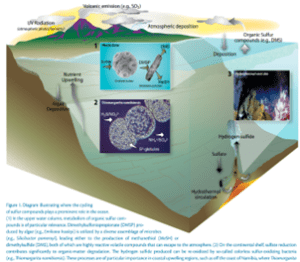
The sulphur cycle is a complex biogeochemical cycle that involves the transformation of sulphur compounds between different oxidation states, such as sulphate, sulphide, and elemental sulphur. Microorganisms in the ocean play an essential role in the sulphur cycle, which has multiple ties to the cycles of other elements, most notably those of carbon, nitrogen, phosphorus, and iron.Incorrect
Answer. B
Statement 1 is incorrect: Soils play a crucial role in phosphorus cycle. Soil microorganisms act as both sinks and sources of available phosphorus in the biogeochemical cycle.
Phosphorus is found in the rocks in abundance. The phosphate salts are broken down from the rocks. These salts are washed away into the ground where they mix in the soil. The organic matter in the soil absorbs the phosphorus, which is used for various biological processes. During this process, soil micro-organisms play a key role in processing and transforming these organic forms of phosphorus into plant-available forms 3. When the plants and animals die, they are decomposed by microorganisms. During this process, the organic form of phosphorus is converted into the inorganic form, which is recycled to soil and water.


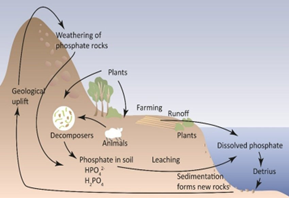
Statement 2 is correct: Oceans play a vital role in the sulphur cycle. The ocean is a major reservoir of sulphur on Earth, with large quantities in the form of dissolved sulphate and sedimentary minerals such as gypsum and pyrite.



The sulphur cycle is a complex biogeochemical cycle that involves the transformation of sulphur compounds between different oxidation states, such as sulphate, sulphide, and elemental sulphur. Microorganisms in the ocean play an essential role in the sulphur cycle, which has multiple ties to the cycles of other elements, most notably those of carbon, nitrogen, phosphorus, and iron. -
Question 9 of 20
9. Question
Consider the following pairs:
Forest fires, recently seen in the news – Location
1. Lahaina – Hawaii
2. Gelendzhik – Russia
3. Bejaia – Italy
How many of the above are correctly matched pairs?Correct
Answer. B
Explanation: Options 1 and 2 are correctly matched pairs.
1. Lahaina – Hawaii
The native cultural sites have been damaged in the recent wildfires that swept across Lahaina region of Hawaii. Lahaina is revered by Native Hawaiians because it has long been the home of ‘Kihawahine’, a woman who transformed into a Moʻo goddess, or a supernatural shapeshifting lizard in Hawaiian religion. Lahaina became the capital of the newly unified Kingdom of Hawaii under Kamehameha and his descendants’ rule. The capital remained in Lahaina until 1845, when King Kamehameha III relocated it to Honolulu, Oahu.


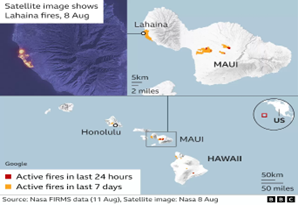
2. Gelendzhik – Russia
Forest fires are rare on Russia’s humid Black Sea coast, but much of Europe has sweltered in a series of heatwaves this summer, causing blazes across the continent. The Climate Change-induced heatwaves have led to wildfires in the Black Sea town of Gelendzhik in Russia.


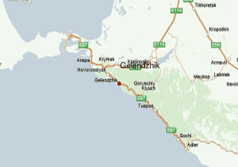
3. Bejaia – Algeria
Northern Algeria has been experiencing a record heatwave in recent days, with temperatures reaching 48C.
Temperatures in several regions in North Africa are up to 7C higher than normal for the time of year. This fanned the winds which spread the forest fires in the mountainous Kabylie region to the east of Algiers and in the coastal towns of Bejaia and Jijel, leading to death of over 30 people.


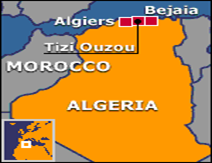 Incorrect
Incorrect
Answer. B
Explanation: Options 1 and 2 are correctly matched pairs.
1. Lahaina – Hawaii
The native cultural sites have been damaged in the recent wildfires that swept across Lahaina region of Hawaii. Lahaina is revered by Native Hawaiians because it has long been the home of ‘Kihawahine’, a woman who transformed into a Moʻo goddess, or a supernatural shapeshifting lizard in Hawaiian religion. Lahaina became the capital of the newly unified Kingdom of Hawaii under Kamehameha and his descendants’ rule. The capital remained in Lahaina until 1845, when King Kamehameha III relocated it to Honolulu, Oahu.



2. Gelendzhik – Russia
Forest fires are rare on Russia’s humid Black Sea coast, but much of Europe has sweltered in a series of heatwaves this summer, causing blazes across the continent. The Climate Change-induced heatwaves have led to wildfires in the Black Sea town of Gelendzhik in Russia.



3. Bejaia – Algeria
Northern Algeria has been experiencing a record heatwave in recent days, with temperatures reaching 48C.
Temperatures in several regions in North Africa are up to 7C higher than normal for the time of year. This fanned the winds which spread the forest fires in the mountainous Kabylie region to the east of Algiers and in the coastal towns of Bejaia and Jijel, leading to death of over 30 people.



-
Question 10 of 20
10. Question
The ‘Global Gibbon Network Initiative’, recently seen in the news, was launched by which one of the following organisations?
Correct
Answer. B
Explanation: The IUCN SSC Primate Specialist Group Section on Small Apes and the International Collaboration to Conserve Gibbons and Siamang have joined forces with The Hainan Institute of National Parks and Eco Foundation Global to establish the Global Gibbon Network Initiative.
Vision
• To safeguard and conserve a key element of Asia’s unique natural heritage: the singing gibbons and their habitats, by promoting participatory conservation policies, legislations, and actions.
For gibbon conservation to be effective, we need to achieve the following Goals:
• Improve conservation awareness for local communities;
• Stabilise and develop livelihood buffer zone communities;
• Harmonise the benefits of conservation and livelihood development, ensuring that the use of wild living resources is sustainable;
• Encourage the participation of local communities and stakeholders in the management of protected areas;
• To become a showcase model of species conservation at international level;
• Promote internal resources for gibbons conservation and development, and other biodiversity values;
• Protect, expand and improve the quality of habitat and create corridors connecting areas of high biodiversity;
• Build wildlife rescue centers, research and store rare genetic resources, improve management and law enforcement capacity, create links of expertise with ex-situ centers (zoo).
Additional information:
• Gibbons are the fastest and smallest of all the apes.
• Gibbons are found in both tropical and sub-tropical forests.
• Hoolock Gibbon is naturally found in the Himalayan region, particularly Northeastern states in India.
• Over the decades, zoologists thought the northeast housed two species of the ape — the eastern hoolock gibbon (Hoolock leuconedys) found in a specific region of Arunachal Pradesh and the western hoolock gibbon (Hoolock hoolock) distributed elsewhere in the northeast.
• A study led by Hyderabad-based Centre for Cellular and Molecular Biology (CCMB) in 2021 proved through genetic analysis that there is only one species of ape in India.
• Gibbons are diurnal (and not nocturnal) species.
• It is an endangered species as per IUCN’s Red List. It is the only gibbon species found in India. It is characterised by its unique mode of locomotion called brachiation.
• arboreal ape species.
• It prefers to live in the upper canopy of the forests.
• They live together in monogamous pairs.
• Gibbons are omnivorous as their diet comprises leaves, flowers, fruits and insects.
• It must be noted that Hoolock Gibbon is a herbivorous animal and its reproduction is viviparous.Incorrect
Answer. B
Explanation: The IUCN SSC Primate Specialist Group Section on Small Apes and the International Collaboration to Conserve Gibbons and Siamang have joined forces with The Hainan Institute of National Parks and Eco Foundation Global to establish the Global Gibbon Network Initiative.
Vision
• To safeguard and conserve a key element of Asia’s unique natural heritage: the singing gibbons and their habitats, by promoting participatory conservation policies, legislations, and actions.
For gibbon conservation to be effective, we need to achieve the following Goals:
• Improve conservation awareness for local communities;
• Stabilise and develop livelihood buffer zone communities;
• Harmonise the benefits of conservation and livelihood development, ensuring that the use of wild living resources is sustainable;
• Encourage the participation of local communities and stakeholders in the management of protected areas;
• To become a showcase model of species conservation at international level;
• Promote internal resources for gibbons conservation and development, and other biodiversity values;
• Protect, expand and improve the quality of habitat and create corridors connecting areas of high biodiversity;
• Build wildlife rescue centers, research and store rare genetic resources, improve management and law enforcement capacity, create links of expertise with ex-situ centers (zoo).
Additional information:
• Gibbons are the fastest and smallest of all the apes.
• Gibbons are found in both tropical and sub-tropical forests.
• Hoolock Gibbon is naturally found in the Himalayan region, particularly Northeastern states in India.
• Over the decades, zoologists thought the northeast housed two species of the ape — the eastern hoolock gibbon (Hoolock leuconedys) found in a specific region of Arunachal Pradesh and the western hoolock gibbon (Hoolock hoolock) distributed elsewhere in the northeast.
• A study led by Hyderabad-based Centre for Cellular and Molecular Biology (CCMB) in 2021 proved through genetic analysis that there is only one species of ape in India.
• Gibbons are diurnal (and not nocturnal) species.
• It is an endangered species as per IUCN’s Red List. It is the only gibbon species found in India. It is characterised by its unique mode of locomotion called brachiation.
• arboreal ape species.
• It prefers to live in the upper canopy of the forests.
• They live together in monogamous pairs.
• Gibbons are omnivorous as their diet comprises leaves, flowers, fruits and insects.
• It must be noted that Hoolock Gibbon is a herbivorous animal and its reproduction is viviparous. -
Question 11 of 20
11. Question
The landscape is practically treeless and the grasses are much shorter but nutritious. The animal diversity is not as high as in the rainforests. Which one of the following biomes is being described here?
Correct
Answer. B
Explanation: About steppe biome:
A steppe is a dry, grassy plain. Steppes occur in temperate climates, which lie between the tropics and polar regions. Temperate regions have distinct seasonal temperature changes, with cold winters and warm summers.
Steppes are semi-arid, meaning they receive 25 to 50 cm (10-20 inches) of rain each year. This is enough rain to support short grasses, but not enough for tall grasses or trees to grow. Many kinds of grasses grow on steppes, but few grow taller than half a meter (20 inches).
Therefore, the Steppes are practically treeless which differentiates them the grasslands of Savanna. Grasses are tall, fresh and nutritious. This is typical of the grass of the wheat-lands in North America (Prairies), the rich black earth or chernozem areas of Russian Ukraine and the better watered areas of the Asiatic Steppes.


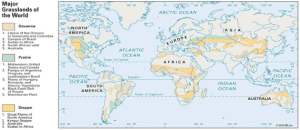
The animal diversity here is poor. However, the open grasslands provide ample space for large herbivores such as gazelles, antelopes, and horses to roam freely. Caravans of horses, donkeys, and camels have travelled the Eurasian steppe for thousands of years.Incorrect
Answer. B
Explanation: About steppe biome:
A steppe is a dry, grassy plain. Steppes occur in temperate climates, which lie between the tropics and polar regions. Temperate regions have distinct seasonal temperature changes, with cold winters and warm summers.
Steppes are semi-arid, meaning they receive 25 to 50 cm (10-20 inches) of rain each year. This is enough rain to support short grasses, but not enough for tall grasses or trees to grow. Many kinds of grasses grow on steppes, but few grow taller than half a meter (20 inches).
Therefore, the Steppes are practically treeless which differentiates them the grasslands of Savanna. Grasses are tall, fresh and nutritious. This is typical of the grass of the wheat-lands in North America (Prairies), the rich black earth or chernozem areas of Russian Ukraine and the better watered areas of the Asiatic Steppes.



The animal diversity here is poor. However, the open grasslands provide ample space for large herbivores such as gazelles, antelopes, and horses to roam freely. Caravans of horses, donkeys, and camels have travelled the Eurasian steppe for thousands of years. -
Question 12 of 20
12. Question
In the context of aquatic biodiversity, consider the following statements:
1. Floating plants are the best examples of nektons.
2. Neuston species are good swimmers that can overcome water currents.
3. Benthic species dwell at the bottom of the oceans.
How many of the above statements are correct?Correct
Answer. A
Explanation:
Statement 1 is incorrect: Floating plants are the best example of neuston. Neuston, also called pleuston, is a group of organisms that live on the surface of the ocean, an estuary, a lake, river, or pond.
Neuston can live on top of the water’s surface or on the underside of it. They could also be found in the surface microlayer that arises between the top and bottom sides of the surface.
Whirligig beetles and water striders are among the insects found in the neuston, as are several spiders and protozoans, as well as worms, snails, insect larvae, and hydras. It is distinct from plankton, which becomes linked with the surface coating through possibility.
Statement 2 is incorrect: Nekton species are good swimmers that can overcome water currents. Nekton are heterotrophic and have a large size range, with familiar examples such as fish, squid, octopus, sharks, and marine mammals. Nekton are usually pelagic, living in the water column, but some are demersal and live close to the bottom, both in the coastal and oceanic habitats.
Statement 3 is correct: Benthic species dwell at the bottom of the oceans, ponds or lakes. Some benthic animals are attached to stones or other organisms while others are buried in the sediment for their entire lives. Examples of benthic species include sponges, mollusc, cnidarian, crustacean etc.


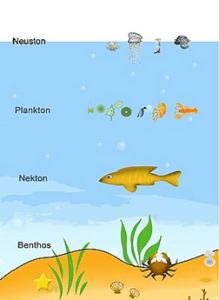 Incorrect
Incorrect
Answer. A
Explanation:
Statement 1 is incorrect: Floating plants are the best example of neuston. Neuston, also called pleuston, is a group of organisms that live on the surface of the ocean, an estuary, a lake, river, or pond.
Neuston can live on top of the water’s surface or on the underside of it. They could also be found in the surface microlayer that arises between the top and bottom sides of the surface.
Whirligig beetles and water striders are among the insects found in the neuston, as are several spiders and protozoans, as well as worms, snails, insect larvae, and hydras. It is distinct from plankton, which becomes linked with the surface coating through possibility.
Statement 2 is incorrect: Nekton species are good swimmers that can overcome water currents. Nekton are heterotrophic and have a large size range, with familiar examples such as fish, squid, octopus, sharks, and marine mammals. Nekton are usually pelagic, living in the water column, but some are demersal and live close to the bottom, both in the coastal and oceanic habitats.
Statement 3 is correct: Benthic species dwell at the bottom of the oceans, ponds or lakes. Some benthic animals are attached to stones or other organisms while others are buried in the sediment for their entire lives. Examples of benthic species include sponges, mollusc, cnidarian, crustacean etc.



-
Question 13 of 20
13. Question
If you wish to see Irrawaddy dolphins, which one of the following is the best place to visit in India?
Correct
Answer. B
Explanation: Chilika lake in Odisha is a major tourist attraction for its Irrawaddy dolphins in India.
Irrawaddy dolphin
Distribution:


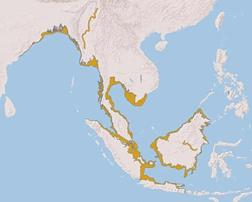
The Irrawaddy dolphin (Orcaella brevirostris) is a euryhaline species of oceanic dolphin found in scattered subpopulations near sea coasts of the Bay of Bengal and Southeast Asia.
It closely resembles the Australian snubfin dolphin.
Habitat: The Irrawaddy dolphin can be found in the following freshwater river systems: Mahakam (Indonesia); the Ayeyarwady, previously called Irrawaddy (Burma); and finally, the Mekong (Laos, Cambodia, and Vietnam).
It is also known to live in Chika Lake in India as well as Songkhla Lake in Thailand.
The Irrawaddy dolphin generally inhabits coastal areas and is not found in offshore waters. It prefers muddy, brackish waters at river mouths and deltas.
Different from other dolphins: As opposed to other dolphins, they are not very active, swimming slowly with sluggish movements.
Irrawaddy dolphins communicate with each other through a wide variety of clicks and buzzing calls, helping them identify individuals.
Diet: Irrawaddy dolphins are carnivores (piscivores and molluscivores). Their diet includes fish, cephalopods, and crustaceans.
IUCN Status: Endangered
India protects the Irrawaddy dolphin in its Schedule I of the Wildlife Protect Act, which bans their killing, transportation, and sale of body parts.Chilika lake
Chilika Lake is a brackish water lake and a shallow lagoon with estuarine character spread across the districts of Puri, Khurda and Ganjam in the state of Odisha in eastern India.
Fed by 52 rivers and rivulets, the waterspread area of Chilika varies between 900 to 1165 sq. km. during summers and monsoon respectively. It is a pear shaped lagoon.
t is the largest wintering ground for migratory waterfowl found anywhere on the Indian sub-continent.
On account of its rich bio-diversity, Chilika lake was designated as a “Ramsar Site”, i.e. a wetland of International Importance. The Nalaban Island within the lake is notified as a Bird Sanctuary under Wildlife (Protection) Act, 1972.
The National Wetlands, Mangroves and Coral Reefs Committee of the Ministry of Environment & Forests, Government of India, have also identified the lake as a priority site for conservation and management.
The Lake is a highly productive ecosystem, with rich fishery resources.
Some of the largest congregation of migratory birds from large parts of Asia, particularly during the winters that arrive from as far as the Caspian Sea, Lake Baikal, Aral Sea, remote parts of Russia, Kirghiz steppes of Mongolia, Central and South East Asia, Ladakh and the Himalayas to feed and breed in its fertile waters.Incorrect
Answer. B
Explanation: Chilika lake in Odisha is a major tourist attraction for its Irrawaddy dolphins in India.
Irrawaddy dolphin
Distribution:



The Irrawaddy dolphin (Orcaella brevirostris) is a euryhaline species of oceanic dolphin found in scattered subpopulations near sea coasts of the Bay of Bengal and Southeast Asia.
It closely resembles the Australian snubfin dolphin.
Habitat: The Irrawaddy dolphin can be found in the following freshwater river systems: Mahakam (Indonesia); the Ayeyarwady, previously called Irrawaddy (Burma); and finally, the Mekong (Laos, Cambodia, and Vietnam).
It is also known to live in Chika Lake in India as well as Songkhla Lake in Thailand.
The Irrawaddy dolphin generally inhabits coastal areas and is not found in offshore waters. It prefers muddy, brackish waters at river mouths and deltas.
Different from other dolphins: As opposed to other dolphins, they are not very active, swimming slowly with sluggish movements.
Irrawaddy dolphins communicate with each other through a wide variety of clicks and buzzing calls, helping them identify individuals.
Diet: Irrawaddy dolphins are carnivores (piscivores and molluscivores). Their diet includes fish, cephalopods, and crustaceans.
IUCN Status: Endangered
India protects the Irrawaddy dolphin in its Schedule I of the Wildlife Protect Act, which bans their killing, transportation, and sale of body parts.Chilika lake
Chilika Lake is a brackish water lake and a shallow lagoon with estuarine character spread across the districts of Puri, Khurda and Ganjam in the state of Odisha in eastern India.
Fed by 52 rivers and rivulets, the waterspread area of Chilika varies between 900 to 1165 sq. km. during summers and monsoon respectively. It is a pear shaped lagoon.
t is the largest wintering ground for migratory waterfowl found anywhere on the Indian sub-continent.
On account of its rich bio-diversity, Chilika lake was designated as a “Ramsar Site”, i.e. a wetland of International Importance. The Nalaban Island within the lake is notified as a Bird Sanctuary under Wildlife (Protection) Act, 1972.
The National Wetlands, Mangroves and Coral Reefs Committee of the Ministry of Environment & Forests, Government of India, have also identified the lake as a priority site for conservation and management.
The Lake is a highly productive ecosystem, with rich fishery resources.
Some of the largest congregation of migratory birds from large parts of Asia, particularly during the winters that arrive from as far as the Caspian Sea, Lake Baikal, Aral Sea, remote parts of Russia, Kirghiz steppes of Mongolia, Central and South East Asia, Ladakh and the Himalayas to feed and breed in its fertile waters. -
Question 14 of 20
14. Question
Consider the following statements:
Statement I: Seaweeds are macroalgae that can offset ocean acidification.
Statement II: Seaweeds absorb CO2 more effectively than trees and forests.
Which one of the following is correct in respect of the above statements?Correct
Answer. A
Explanation:
Statement 1 is correct: Seaweeds, otherwise known as marine macroalgae are primitive non-flowering photosynthetic macrophytes occurring in tidal regions of seas and oceans that occupy 71% of the globe and they are natural renewable resources. Green, brown and red seaweeds are generally distributed in the intertidal, tidal and subtidal regions respectively. They have the capacity to offset ocean acidification.
Now seaweed farming is starting to gain momentum in other parts of the world, in part due to growing awareness of the species’ ability to combat climate change as well as its high nutritional value and fast growth.
Statement 2 is correct and explains statement 1: Kelp is one of the most commonly farmed types of seaweed. The large, brown alga, which is found in cold, coastal marine waters around the world, grows remarkably quickly – up to 61cm (2ft) a day – and does not require fertiliser or weeding. Seaweeds (such as kelp) absorbs CO2 more effectively than trees. It also improves water quality by extracting harmful nutrients such as nitrogen from the sea.
Like plants on land, seaweed uses photosynthesis to absorb CO2 and grow biomass. Coastal marine systems can absorb carbon at rates up to 50 times greater than forests on land.
Additional information: USES OF SEAWEEDS:
• As food and feed
• Raw material for biofuels and bio-plastics
• As fertiliser
• Marine restoration by absorbing excess nitrogen from water bodies
• Aquaculture
• In cosmetics, medicine and food productionIncorrect
Answer. A
Explanation:
Statement 1 is correct: Seaweeds, otherwise known as marine macroalgae are primitive non-flowering photosynthetic macrophytes occurring in tidal regions of seas and oceans that occupy 71% of the globe and they are natural renewable resources. Green, brown and red seaweeds are generally distributed in the intertidal, tidal and subtidal regions respectively. They have the capacity to offset ocean acidification.
Now seaweed farming is starting to gain momentum in other parts of the world, in part due to growing awareness of the species’ ability to combat climate change as well as its high nutritional value and fast growth.
Statement 2 is correct and explains statement 1: Kelp is one of the most commonly farmed types of seaweed. The large, brown alga, which is found in cold, coastal marine waters around the world, grows remarkably quickly – up to 61cm (2ft) a day – and does not require fertiliser or weeding. Seaweeds (such as kelp) absorbs CO2 more effectively than trees. It also improves water quality by extracting harmful nutrients such as nitrogen from the sea.
Like plants on land, seaweed uses photosynthesis to absorb CO2 and grow biomass. Coastal marine systems can absorb carbon at rates up to 50 times greater than forests on land.
Additional information: USES OF SEAWEEDS:
• As food and feed
• Raw material for biofuels and bio-plastics
• As fertiliser
• Marine restoration by absorbing excess nitrogen from water bodies
• Aquaculture
• In cosmetics, medicine and food production -
Question 15 of 20
15. Question
Consider the following statements about the Blue Flag Certification:
1. It is a recognition given to beaches, marinas and boating tourism facilities.
2. Netherlands-based ‘Foundation for Environment Education’ awards this certification.
Which of the statements given above is/are correct?Correct
Answer. A
Explanation:
Statement 1 is correct: The Blue Flag Certification Programme for beaches, marinas and sustainable boating facilities is run by the international, non-governmental, non-profit organisation FEE (the Foundation for Environmental Education). The Blue Flag Programme started in France in 1985. It has been implemented in Europe since 1987 and in areas outside of Europe since 2001, when South Africa joined. Today, Blue Flag has become a truly global Programme, with an ever-increasing number of countries participating in it.
The Blue Flag Programme promotes sustainable development in freshwater and marine areas. It challenges local authorities and beach operators to achieve high standards in the four categories of: water quality, environmental management, environmental education and safety.
Statement 2 is incorrect: Established in 1981, the Foundation for Environmental Education (FEE) is one of the world’s largest environmental education organisations, with over 100 member organisations in 81 countries. It is based in Copenhagen, Denmark. It awards the Blue Flag Certification.
Additional information:
• There are 12 Indian beaches included in the blue flag list: Shivrajpur-Gujarat, Ghoghla-Diu, Kasarkod and Padubidri-Karnataka, Kappad-Kerala, Rushikonda- Andhra Pradesh, Golden-Odisha, Radhanagar- Andaman and Nicobar, Kovalam in Tamil Nadu, Eden in Puducherry beaches, Thundi Beach- Lakshadweep archipelago and Kadmat Beach-Lakshadweep archipelago.
• Blue Flag beaches are considered the cleanest beaches of the world. It is an eco-tourism model endeavouring to provide the tourists/beachgoers clean and hygienic bathing water, facilities, a safe and healthy environment and sustainable development of the area.
• On the lines of Blue Flag certification, India has also launched its own eco-label BEAMS (Beach Environment & Aesthetics Management Services).Incorrect
Answer. A
Explanation:
Statement 1 is correct: The Blue Flag Certification Programme for beaches, marinas and sustainable boating facilities is run by the international, non-governmental, non-profit organisation FEE (the Foundation for Environmental Education). The Blue Flag Programme started in France in 1985. It has been implemented in Europe since 1987 and in areas outside of Europe since 2001, when South Africa joined. Today, Blue Flag has become a truly global Programme, with an ever-increasing number of countries participating in it.
The Blue Flag Programme promotes sustainable development in freshwater and marine areas. It challenges local authorities and beach operators to achieve high standards in the four categories of: water quality, environmental management, environmental education and safety.
Statement 2 is incorrect: Established in 1981, the Foundation for Environmental Education (FEE) is one of the world’s largest environmental education organisations, with over 100 member organisations in 81 countries. It is based in Copenhagen, Denmark. It awards the Blue Flag Certification.
Additional information:
• There are 12 Indian beaches included in the blue flag list: Shivrajpur-Gujarat, Ghoghla-Diu, Kasarkod and Padubidri-Karnataka, Kappad-Kerala, Rushikonda- Andhra Pradesh, Golden-Odisha, Radhanagar- Andaman and Nicobar, Kovalam in Tamil Nadu, Eden in Puducherry beaches, Thundi Beach- Lakshadweep archipelago and Kadmat Beach-Lakshadweep archipelago.
• Blue Flag beaches are considered the cleanest beaches of the world. It is an eco-tourism model endeavouring to provide the tourists/beachgoers clean and hygienic bathing water, facilities, a safe and healthy environment and sustainable development of the area.
• On the lines of Blue Flag certification, India has also launched its own eco-label BEAMS (Beach Environment & Aesthetics Management Services). -
Question 16 of 20
16. Question
Consider the following:
1. Horn of Africa
2. Western Ghats
3. Western Himalayas
4. Eastern Himalayas
5. Caribbean islands
How many of the above are designated as ‘Biodiversity Hotspots’ by the Conservation International?Correct
Answer. C
Explanation: Options 1, 2, 4 and 5 are correct.
To be classified as a biodiversity hotspot by the Conservation International, the region must meet these two conditions:
• Must contain at least 0.5% or 1,500 species of vascular plants as endemic to the area.
• There must have been at least 70% loss of its primary habitat.
36 ecological hotspots in the world fulfil this criterion:


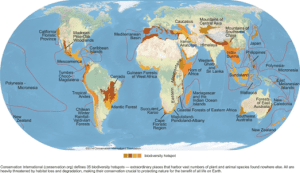 Incorrect
Incorrect
Answer. C
Explanation: Options 1, 2, 4 and 5 are correct.
To be classified as a biodiversity hotspot by the Conservation International, the region must meet these two conditions:
• Must contain at least 0.5% or 1,500 species of vascular plants as endemic to the area.
• There must have been at least 70% loss of its primary habitat.
36 ecological hotspots in the world fulfil this criterion:



-
Question 17 of 20
17. Question
Which of the following best describes the objectives of the Bonn challenge, sometimes seen in the news?
Correct
Answer. D
Explanation: The Bonn Challenge is a global goal to bring 150 million hectares of degraded and deforested landscapes into restoration by 2020 and 350 million hectares by 2030.
The Government of India made a Bonn Challenge pledge to bring under restoration 13 million hectares of degraded land by 2020 and an additional 8 million hectares by 2030.
Launched by the Government of Germany and IUCN in 2011, the Challenge surpassed the 150-million-hectare milestone for pledges in 2017.
To achieve these goals, it relies on a flexible, nuanced approach to restoration called forest landscape restoration (FLR). FLR restores ecological integrity while enhancing human well-being.
IUCN and the World Wide Fund for Nature (WWF) coined the term forest landscape restoration in 2000 as a framework for managing landscapes, complementing both forest conservation and sustainable management.Incorrect
Answer. D
Explanation: The Bonn Challenge is a global goal to bring 150 million hectares of degraded and deforested landscapes into restoration by 2020 and 350 million hectares by 2030.
The Government of India made a Bonn Challenge pledge to bring under restoration 13 million hectares of degraded land by 2020 and an additional 8 million hectares by 2030.
Launched by the Government of Germany and IUCN in 2011, the Challenge surpassed the 150-million-hectare milestone for pledges in 2017.
To achieve these goals, it relies on a flexible, nuanced approach to restoration called forest landscape restoration (FLR). FLR restores ecological integrity while enhancing human well-being.
IUCN and the World Wide Fund for Nature (WWF) coined the term forest landscape restoration in 2000 as a framework for managing landscapes, complementing both forest conservation and sustainable management. -
Question 18 of 20
18. Question
Consider the following statements regarding Project RE-HAB:
Statement I: It aims to address the issue of human-animal conflict.
Statement II: The Wildlife Institute of India (WII) seeks to create bee-fences around the select protected areas.
Which one of the following is correct in respect of the above statements?Correct
Answer. C
Explanation:
Statement 1 is correct but statement 2 is incorrect: The RE-HAB Project is an initiative under the Honey Mission Programme launched by Khadi and Village Industries Commission (KVIC), Ministry of Micro, Small and Medium Enterprises.
Under the Project RE-HAB, “Bee-fences” are created by setting up bee boxes in the passage ways of elephants to block their entrance to human habitats. The boxes are connected with a string so that when elephants attempt to pass through, a tug or pull causes the bees to swarm the elephant herds and dissuade them from moving further. In this way, it seeks to prevent human-animal conflict.
This is a cost-effective way of reducing human-wild conflicts without causing any harm to the animal. It is scientifically recorded that elephants fear the bee swarms that can bite their sensitive inner side of the trunk and eyes. The collective buzz of the bees annoys elephants which force them to return.Incorrect
Answer. C
Explanation:
Statement 1 is correct but statement 2 is incorrect: The RE-HAB Project is an initiative under the Honey Mission Programme launched by Khadi and Village Industries Commission (KVIC), Ministry of Micro, Small and Medium Enterprises.
Under the Project RE-HAB, “Bee-fences” are created by setting up bee boxes in the passage ways of elephants to block their entrance to human habitats. The boxes are connected with a string so that when elephants attempt to pass through, a tug or pull causes the bees to swarm the elephant herds and dissuade them from moving further. In this way, it seeks to prevent human-animal conflict.
This is a cost-effective way of reducing human-wild conflicts without causing any harm to the animal. It is scientifically recorded that elephants fear the bee swarms that can bite their sensitive inner side of the trunk and eyes. The collective buzz of the bees annoys elephants which force them to return. -
Question 19 of 20
19. Question
Consider the following statements:
1. ENVIS is a decentralised government-owned and operated network for information on environment in India.
2. ENVIS is a part of the international initiative called INFOTERRA.
3. INFOTERRA is a global environmental information network of the World Bank.
How many of the above statements are correct?Correct
Answer. B
Explanation:
Statement 1 is correct: Realising the importance of Environmental Information, the Government of India, in December, 1982, established an Environmental Information System (ENVIS) as a plan programme. The focus of ENVIS since inception has been on providing environmental information to decision makers, policy planners, scientists and engineers, research workers, etc. all over the country.
Funded by World Bank, ENVIS is a decentralised information system network consisting of a focal point in the Ministry of Environment and Climate Change coordinating the activities of a chain of 28 nodes in subject specific areas known as ENVIS Centres located in various prestigious institutions/ organisations all over the country.
Statement 2 is correct but statement 3 is incorrect: ENVIS is the Asia’s subregional node of the UNEP’s INFOTERRA environmental system. The purpose of the ENVIS Centre is to cater to the needs of the people, who do not have access to highly equipped libraries and network systems. ENVIS was designated as the Regional Service Centre (RSC) of INFOTERRA of UNEP in 1985 for the South Asia Sub-Region countries.
INFOTERRA has its international headquarters in Kenya and is a global information network operated by the Earth-watch program of the United Nations Environment Program (UNEP).
Under INFOTERRA, participating nations designate institutions to be national focal points, such as the Environmental Protection Agency (EPA) in the United States. Each national institution chosen as a focal point, prepares a list of its national environmental experts and selects what it considers the best sources for inclusion in INFOTERRA’s international directory of experts.Incorrect
Answer. B
Explanation:
Statement 1 is correct: Realising the importance of Environmental Information, the Government of India, in December, 1982, established an Environmental Information System (ENVIS) as a plan programme. The focus of ENVIS since inception has been on providing environmental information to decision makers, policy planners, scientists and engineers, research workers, etc. all over the country.
Funded by World Bank, ENVIS is a decentralised information system network consisting of a focal point in the Ministry of Environment and Climate Change coordinating the activities of a chain of 28 nodes in subject specific areas known as ENVIS Centres located in various prestigious institutions/ organisations all over the country.
Statement 2 is correct but statement 3 is incorrect: ENVIS is the Asia’s subregional node of the UNEP’s INFOTERRA environmental system. The purpose of the ENVIS Centre is to cater to the needs of the people, who do not have access to highly equipped libraries and network systems. ENVIS was designated as the Regional Service Centre (RSC) of INFOTERRA of UNEP in 1985 for the South Asia Sub-Region countries.
INFOTERRA has its international headquarters in Kenya and is a global information network operated by the Earth-watch program of the United Nations Environment Program (UNEP).
Under INFOTERRA, participating nations designate institutions to be national focal points, such as the Environmental Protection Agency (EPA) in the United States. Each national institution chosen as a focal point, prepares a list of its national environmental experts and selects what it considers the best sources for inclusion in INFOTERRA’s international directory of experts. -
Question 20 of 20
20. Question
Consider the following institutions:
1. National Environmental Engineering Research Institute (NEERI)
2. Central Pollution Control Board (CPCB)
3. State Pollution Control Board (SPCB)
4. National Green Tribunal (NGT)
How many of the above are authorised to monitor the air quality and meteorological parameters, as per the National Air Quality Monitoring Plan (NAMP)?Correct
Answer. C
Explanation: Options 1 ,2 and 3 are correct.
PM10 are inhalable coarse particles, which are particles with a diameter between 2.5 and 10 micrometers (μm) and PM2.5 are fine particles with a diameter of 2.5 μm or less. Particulates are the deadliest form of air pollutants due to their ability to penetrate deep into the lungs and blood streams unfiltered. The smaller PM2.5 are particularly deadly as it can penetrate deep into the lungs.
The government is executing a nation-wide programme of ambient air quality monitoring known as National Air Quality Monitoring Plan (NAMP). The network consists of 703 manual operating stations covering 307 cities/towns in 29 states and 6 Union Territories of the country.
Under NAMP, four air pollutants viz. SO2, NO2, suspended particulate matter (PM10), and fine particulate matter (PM2.5) have been identified for regular monitoring at all the locations.
In addition, there are 134 real-time Continuous Ambient Air Quality Monitoring stations (CAAQMS) in 71 cities across 17 states, monitoring 08 pollutants viz. PM10, PM2.5, SO2, NOx , ammonia (NH3), CO, ozone (O3), and benzene.
The monitoring of meteorological parameters, such as wind speed and wind direction, relative humidity (RH), and temperature were also integrated with the monitoring of the air quality. The monitoring of pollutants is carried out for 24 hours (a 4-hourly sampling for gaseous pollutants and an 8-hourly sampling for particulate matter) twice a week, to have 104 observations in a year.
The monitoring is being carried out with the help of the Central Pollution Control Board (CPCB), State Pollution Control Boards (SPCB), Pollution Control Committees (PCC), National Environmental Engineering Research Institute (NEERI).
The CPCB co-ordinates with these agencies to ensure uniformity and consistency of air quality data and provides technical and financial support for operating the monitoring stations.Incorrect
Answer. C
Explanation: Options 1 ,2 and 3 are correct.
PM10 are inhalable coarse particles, which are particles with a diameter between 2.5 and 10 micrometers (μm) and PM2.5 are fine particles with a diameter of 2.5 μm or less. Particulates are the deadliest form of air pollutants due to their ability to penetrate deep into the lungs and blood streams unfiltered. The smaller PM2.5 are particularly deadly as it can penetrate deep into the lungs.
The government is executing a nation-wide programme of ambient air quality monitoring known as National Air Quality Monitoring Plan (NAMP). The network consists of 703 manual operating stations covering 307 cities/towns in 29 states and 6 Union Territories of the country.
Under NAMP, four air pollutants viz. SO2, NO2, suspended particulate matter (PM10), and fine particulate matter (PM2.5) have been identified for regular monitoring at all the locations.
In addition, there are 134 real-time Continuous Ambient Air Quality Monitoring stations (CAAQMS) in 71 cities across 17 states, monitoring 08 pollutants viz. PM10, PM2.5, SO2, NOx , ammonia (NH3), CO, ozone (O3), and benzene.
The monitoring of meteorological parameters, such as wind speed and wind direction, relative humidity (RH), and temperature were also integrated with the monitoring of the air quality. The monitoring of pollutants is carried out for 24 hours (a 4-hourly sampling for gaseous pollutants and an 8-hourly sampling for particulate matter) twice a week, to have 104 observations in a year.
The monitoring is being carried out with the help of the Central Pollution Control Board (CPCB), State Pollution Control Boards (SPCB), Pollution Control Committees (PCC), National Environmental Engineering Research Institute (NEERI).
The CPCB co-ordinates with these agencies to ensure uniformity and consistency of air quality data and provides technical and financial support for operating the monitoring stations.

